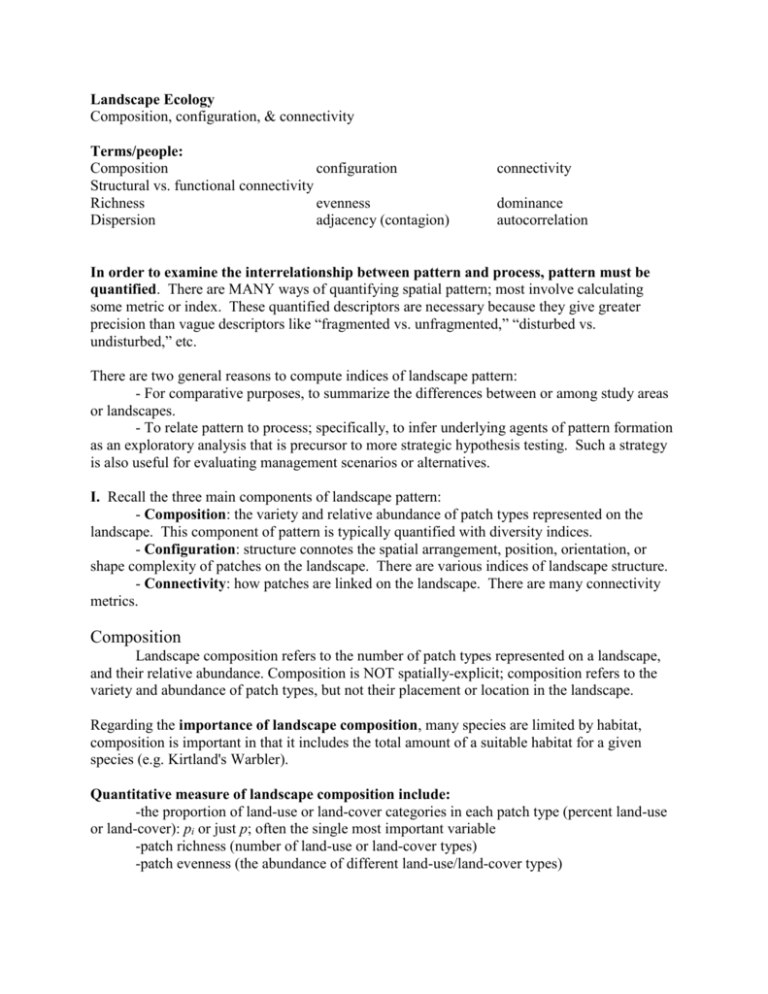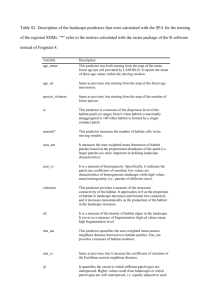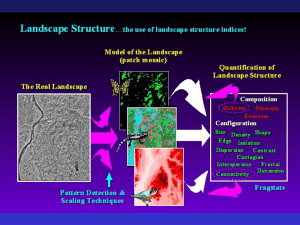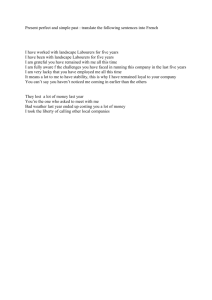Composition, configuration, & connectivity
advertisement

Landscape Ecology Composition, configuration, & connectivity Terms/people: Composition configuration Structural vs. functional connectivity Richness evenness Dispersion adjacency (contagion) connectivity dominance autocorrelation In order to examine the interrelationship between pattern and process, pattern must be quantified. There are MANY ways of quantifying spatial pattern; most involve calculating some metric or index. These quantified descriptors are necessary because they give greater precision than vague descriptors like “fragmented vs. unfragmented,” “disturbed vs. undisturbed,” etc. There are two general reasons to compute indices of landscape pattern: - For comparative purposes, to summarize the differences between or among study areas or landscapes. - To relate pattern to process; specifically, to infer underlying agents of pattern formation as an exploratory analysis that is precursor to more strategic hypothesis testing. Such a strategy is also useful for evaluating management scenarios or alternatives. I. Recall the three main components of landscape pattern: - Composition: the variety and relative abundance of patch types represented on the landscape. This component of pattern is typically quantified with diversity indices. - Configuration: structure connotes the spatial arrangement, position, orientation, or shape complexity of patches on the landscape. There are various indices of landscape structure. - Connectivity: how patches are linked on the landscape. There are many connectivity metrics. Composition Landscape composition refers to the number of patch types represented on a landscape, and their relative abundance. Composition is NOT spatially-explicit; composition refers to the variety and abundance of patch types, but not their placement or location in the landscape. Regarding the importance of landscape composition, many species are limited by habitat, composition is important in that it includes the total amount of a suitable habitat for a given species (e.g. Kirtland's Warbler). Quantitative measure of landscape composition include: -the proportion of land-use or land-cover categories in each patch type (percent land-use or land-cover): pi or just p; often the single most important variable -patch richness (number of land-use or land-cover types) -patch evenness (the abundance of different land-use/land-cover types) Evenness generally is reported as the function of the maximum diversity possible for a given richness (evenness = 1 when the patch mosaic is perfectly diverse given the observed patch richness and a particular diversity formula; approaches 0 as evenness decreases). Evenness is sometimes reported as "dominance" by subtracting it from 1. -patch diversity (combines richness and evenness into a single metric) In lab, you will use FRAGSTATS to calculate various diversity indices, including the most common, Shannon's and Simpson's indices. Configuration With landscape configuration, we are interested in the spatial character and arrangement, position, orientation, or shape complexity of patches. Some aspects of configuration measure the location of one patch types relative to another (patch isolation or contagion), others are measures of the spatial character of a given patch (shape and core area): -Size, size distribution, and density - Patch size is important as we’ve already discussed regarding the species-area relationship. Patch size distribution is simply relative abundance or frequency of patches in different sizes categories. These are often illustrated with size classes ordered on a doubling or log scale, because the range in sizes can be quite large for many landscapes. Patch density is simply the number of patches per unit area. -Isolation/proximity - These metrics represent the tendency for patches to be relatively isolated in space from other patches of the same class, often summarized as the mean nearest-neighbor distance over all patches. Affects connectivity. Can be measured straight-line (“as the crow flies”) or via the actual travel route used. -Dispersion - Dispersion connotes the tendency for patches to be regularly or contagiously distributed ("clumped") with respect to each other. A common approach is to use nearest-neighbor distances between patches of the same type, reporting the statistic as the relative variability in the nearest neighbor distance. If the variance is greater than the mean, patches are clumped; if the variance is less than the mean, patches are uniform. This also can be averaged over all patches of all types to provide a landscape-scale index of dispersion. -Shape complexity - Various measures of shape complexity are based on the relative amount of edge per unit area. Commonly, this is indexed in terms of edge-to-area ratios. Shape complexity connotes the geometry of patches: whether they tend to be simple and compact, or irregular and convoluted. Generally, higher values mean greater complexity, though the interpretation varies among the different metrics. -Adjacency (contagion) - Adjacency refers to the tendency for elements (cells or patches) of a given type to occur next to patches of another type (or in some cases, the same type). This can be expressed as a matrix of pairwise adjacencies between all patch types, where the elements of the matrix are the proportions of edges in each pairwise type. Sometimes, this matrix is averaged to provide an overall index of contagion, i.e., the tendency for patches to occur in pure clumps as compared to highly interspersed ("salt and pepper") mixtures. Connectivity - “the degree to which the landscape facilitates or impedes movement” (Taylor et al. 1993, p. 571) Connectivity generally refers to functional joinings or connections between patches. What constitutes a "functional connection" between patches clearly depends on the application or process of interest; patches that are connected for bird dispersal might not be connected for salamanders or for hydrologic flow. Connectivity may be based on: -Strict adjacency (touching) or some threshold distance (a maximum dispersal distance); -Some decreasing function of distance that reflects the probability of connection at a given distance. structural vs. functional connectivity (Calabrese and Fagan 2004) - This makes connectivity often the most difficult of the 3 C’s to measure. See also Bélisle (2005). II. More than 1 metric is usually needed to accurately and thoroughly quantify composition, configuration, or connectivity. There are literally hundreds of landscape metrics available today, and many of these quantify a similar or identical aspect of landscape structure. Therefore, many metrics will be correlated, either because they describe the same thing or simply because they are statistically correlated, and the user must choose the appropriate metrics to use in their investigation. An appropriate subset of metrics should explain pattern variability across the landscape in question, but should also minimize this redundancy. Riitters et al. (1995) summarized the major components of pattern in a large number of sample landscapes (classified satellite imagery) and used a multivariate analysis to reduce these to a smaller set of non-redundant (minimally correlated) indices. They found that only five metrics could capture most of the variability in their samples: 1) Average patch perimeter/area ratio ("patch compaction") 2) Image texture (the contagion index based on the Shannon function) 3) Average patch shape (patch area normalized to the area of a square with the same perimeter) 4) Patch perimeter-area scaling (average fractal dimension of patches with perimeters defined as inside edges of each patch) 5) Number of attribute classes (patch richness) III. Once pattern is quantified (in terms of composition, configuration, and connectivity), then how do we quantitatively compare landscapes? –> Spatial statistics (a key focus in lab) Spatial stats vs. regular stats: assumptions of autocorrelation vs. stationarity References Beier, P., and R.F. Noss. 1998. Do habitat corridors provide connectivity? Conserv. Biol. 12:1241-1252. Bélisle, M. 2005. Measuring landscape connectivity: the challenge of behavioral landscape ecology. Ecology 86:1988-1995. Calabrese, J.M., and W.F. Fagan. 2004. A comparison shoppers' guide to connectivity metrics: Trading off between data requirements and information content. Frontiers in Ecology and the Environment 2:529-536. Riitters, K.H., R.V. O'Neill, C.T. Hunsaker, J.D. Wickham, D.H. Yankee, S.P. Timmins, K.B. Jones, and B.L. Jackson. 1995. A factor analysis of landscape pattern and structure metrics. Landscape Ecology 10:23-39. Taylor, P.D., L. Fahrig, K. Henein, and G. Merriam. 1993. Connectivity is a vital element of landscape structure. Oikos 68:571-573.









